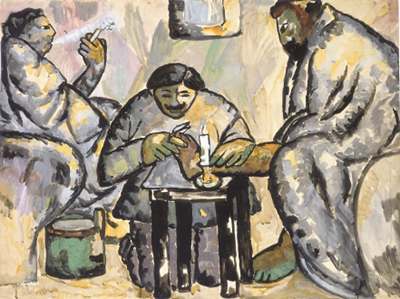The Corn Cutter is a painting by Kazimir Malevich from around 1911-1912. It is also sometimes known by the alternative name of Chiropodist at the Baths. This is one of many paintings to be found at the Stedelijk Museum in Amsterdam, Netherlands.
We find three main figures within this artwork, two of which interact with each other in the foreground. A large man to the right lays his leg out on a table, whilst another man looks at it with a strong focus. He holds the foot with care, whilst holding the leg in place with the other hand. The corn cutter, or chiropodist, is therefore examining the foot to decide an appropriate course of action. This somewhat uncomfortable content may not be to everyone's taste but is shows again and artist who is willing to try out new ideas, both stylistically and also in terms of the content that he covered. The composition has been compared to other historical paintings in how a central figure lurks around a table in the centre of the work, and then others support him by grouping around. The third figure is seen smoking in the background to the left, perhaps another worker who is taking some time off or maybe a client waiting to be seen to. In terms of specific artworks, some have even compared the layout to Cezanne's Cardplayers from 1890-1892 and he also liked to capture the lives of ordinary people in his own region.
The painting is around one metre in width and 78cm in height, making it slightly larger than most artworks produced by Malevich during this period. He used gouache and charcoal to put this piece together and it was first exhibited in 1912, making it likely that Malevich put together a number of items specifically for what was known as the Donkey's Tail exhibition. Elements to notice within The Corn Cutter include the oversized feet which was a common addition within his figurative work. The tones are darker here than in his fauvist paintings, perhaps in an attempt to create a different mood which better represented this small room besides a bath house. No doubt, visitors would swim and relax before being seen to by the chiropodist. Notice also how the artist deliberately allows the figures to extend to the edges of the painting, sometimes even beyond that, which is more of a sign of contemporary western art, when traditional techniques would not accept this approach. The influence of Japanese art would encourage new methods of cropping compositions, as well as later techniques from photography.
One might instead term this piece Neo-primitive as he turns his back on the brighter tones of Fauvism, but there are also many elements which cross-over between different styles. Some historians have also drawn comparisons to the layout of some religious artworks by Andrei Rublev though this is a harder case to prove. In fact, there are so many famous paintings from the past, that all manner of links can be suggested purely on visual similarities in anything from layout to colour to the ways in which forms are produced. Personally, the Van Gogh classic of the Potato Eaters feels most similar in terms of atmosphere and content, as that also focuses on an intimate, dark situation of the local community when most artists would not consider covering such a scene. The painting can be found at the Stedelijk Museum in Amsterdam, alongside a number of other paintings from his career.




